User Manual
Weiss Compressor/Limiter
Intro
Differences between Weiss DS1-MK3 and Compressor/Limiter
Main display features
Extended Features
Credits
Weiss Compressor/Limiter is a versatile mixing and mastering unit based on the Weiss DS1-MK3 and has advanced features like FFT display, waveform display auto release and parallel mix. The Compressor/Limiter is was created to take the gold-standard DS1-MK3 experience to a new level of usability and workflows.
Differences between Weiss DS1-MK3 and Compressor/Limiter.
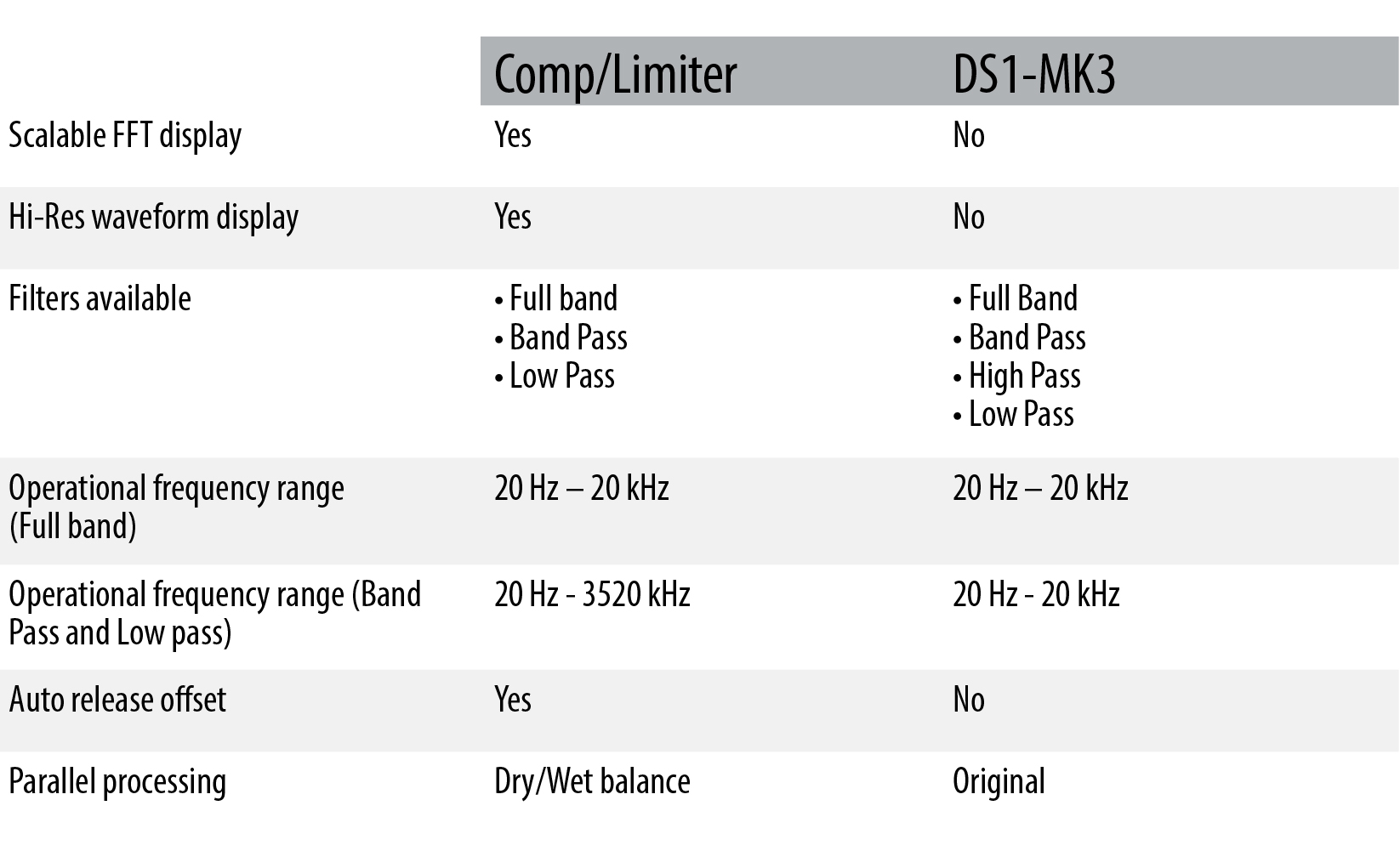
The main display has several modes: Waveform, Frequency and Knee.
Waveform display
Waveform display is handy for controlling how much of the gain reduction occurs and when in time. It shows the peaks, RMS and gain reduction graphs.
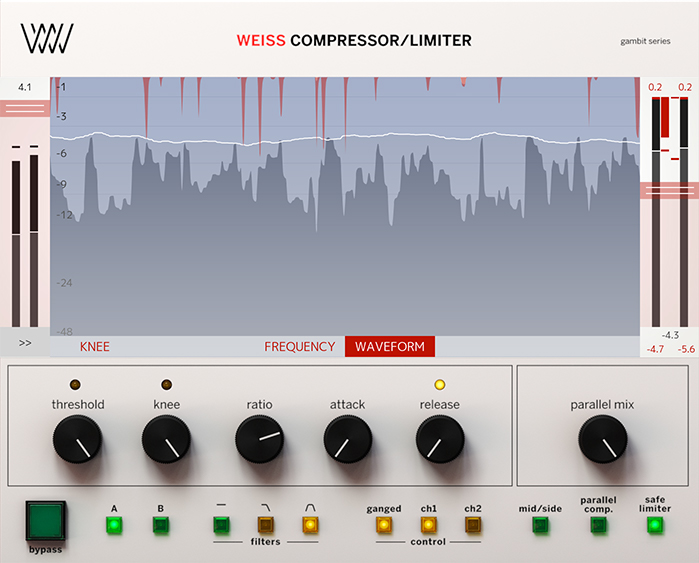
Frequency display
Frequency display is useful to zoom in on a certain frequency when in a band selection mode.
On the Frequency display you can change Frequency, Threshold and Width of the filters. Each parameter has its own click area on the widget. To change the parameter setting, click and drag the selected click area.
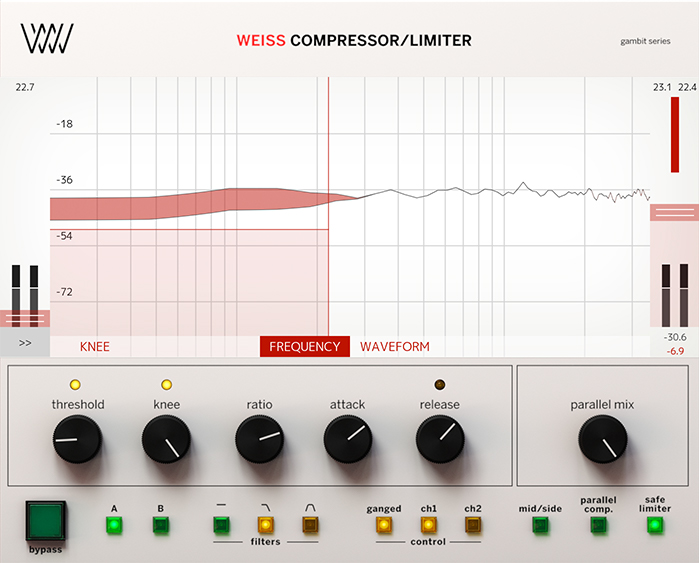
Threshold: Sets the level which the envelope signal has to reach before gain reduction is applied.
Frequency: Sets the center frequency of the filter.
Width: Sets the width of the filter.
Knee Display
Knee display shows the knee shape of the compressor.
Soft-knee: Determines how much the knee is rounded. The maximum setting (1.0) chooses a curve that reaches from 0dBFS down to twice the threshold value. This implies that if soft-knee is engaged the signal is already affected even if its envelope lies below the threshold.
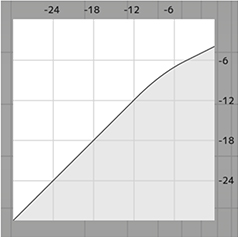
Meters
Input Gain: Shows Peak and RMS levels.
Output Gain: Shows the peak and RMS levels.
Gain Reduction Meters: In stereo mode, the gain reduction meters show gain reduction for L and R channels per band while in Mid/Side mode, the gain reduction meters show gain reduction for M and S.
Parameters
Ratio: Sets the slope of the segment above the threshold. The ratio can be adjusted for compression or expansion, depending on the requirement.
Attack and Preview: The longer the attack time, the more will the leading edge of fast transients pass by the gain reduction circuit unaltered (as in Graphic 9 during attack phase). Very fast attack time settings such as 20µs, i.e. one sample period, do catch every transient, but may distort low frequencies. To utilise longer attack times and still catch fast transients, use preview.
Release and Average: The input signal is monitored with two different methods: peak amplitude and RMS value. The peak amplitude is the programme portion we don't perceive as very loud, however which can easily cause overloads. The RMS value of the programme material we perceive as loudness. Its variations contribute most to the dynamic range of the audio. The sidechain processor compares the two measurements it obtained from the peaks and the RMS. The ratio between the two determines which time constant would be the appropriate release, e.g. after short duration peak the faster release will be applied during the release phase. The time period over which the RMS value of the programme material is averaged is set by the "average" parameter. The effect of the average parameter can best be studied on the gain reduction meter. Fast "average" settings will cause most of the gain reduction meter to move very fast (depending on the "release fast" setting) , slower settings will just have the top part of the gain reduction move fast, with the bottom part depending on the "release slow" setting.
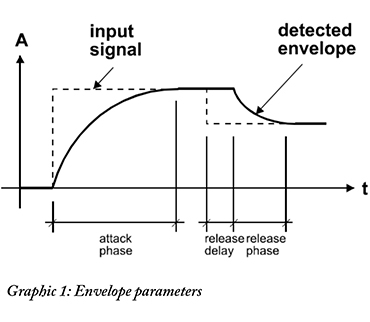
Auto release offset: Allows to control all three release parameters (Release Fast, Release Slow and Average) with one Release knob on the main screen. The feature adds the defined offset between Release Fast, Release Slow and Average. If Auto Release Offset is set to 100 ms and Release Fast is set to 50 ms, Release Slow will be automatically calculated as 150 ms and will change proportionally to Release Fast. TIP: It is possible to turn off the Auto Release Offset feature in the Side Panel. In this case all three release parameters (Release Fast, Release Slow and Average) wil have to be set manually.
Release Delay: Normally the release phase begins immediately after the programme material has fallen in level. The release delay determines how long the Compressor/Limiter holds the current level before entering release (see Graphic 9). The resulting dynamic characteristic is very smooth and avoids otherwise typical 'pumping' effects. The ideal setting is programme dependent and experimentation may be necessary to achieve the best combination of all dynamic parameters.
Parallel mix: The parallel processing feature is implemented as a DRY/WET mix. Parallel Comp. button activates and disables the parallel processing for instant A/Bing.
TIP: Any move of the Parallel Mix button will enable the parallel processing if it was turned off.
Band Selective Mode: In this mode, a frequency crossover is put into the signal path, splitting it up into two or three bands, depending on the filter type setting. One of the bands is compressed, the other is delayed by the same amount used as „delay“ in the compressor stage. This mode is completely transparent if no gain reduction is applied.
Filter Type: Selects the available filter types: Low Pass and Band Pass.
Ganged /Unganged: The Compressor/Limiter allows for independent parameter settings in channels 1 and 2. If the ganged key is lit, both channels operate with the same parameter set. If the ganged key is not lit, the two channels can operate with different parameters. The CH1 and CH2, Mid/Side key assigns the knobs and the display to the appropriate channel.
Mid/Side Mode and Sidechain Link: The Compressor/Limiter can be switched to Mid / Side mode. In M/S mode it usually is preferable to set the channels unganged and the sidechain unlinked, Channel 1 will operate as M part and Channel 2 will operate as S part.
Side Panel
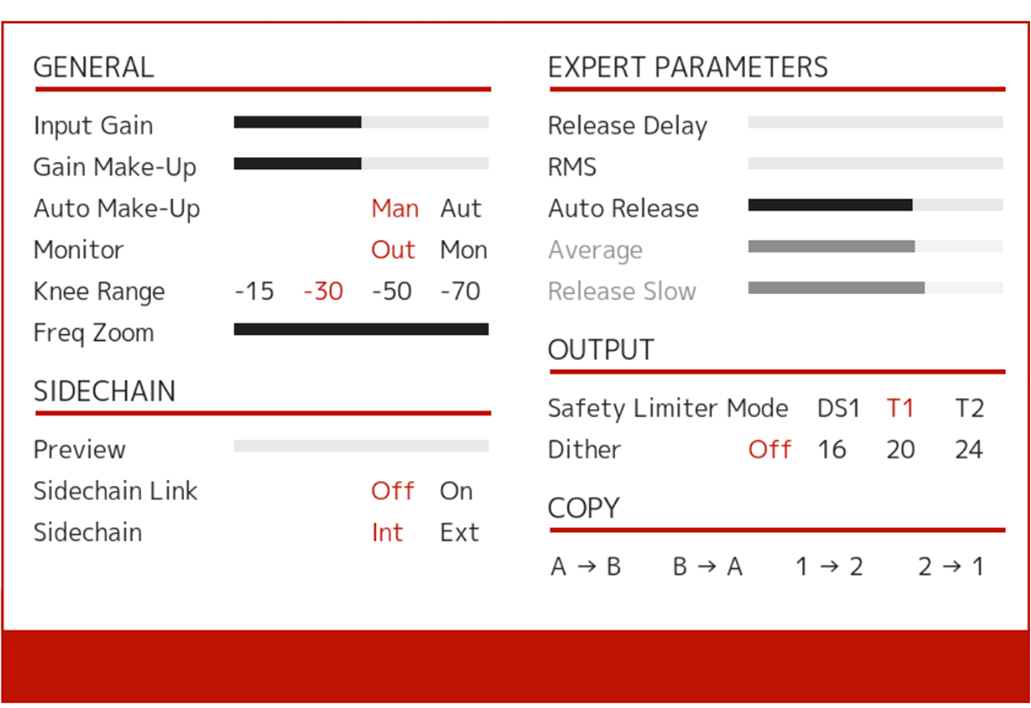
On the side panel you can find additional parameters.
Output: There are three types of limiters available in Compressor/Limiter plug-in:
-Original Safe limiter from DS1-MK3 hardware
- New generation Weiss brick-wall Limiter Type 1
- New generation Weiss brick-wall Limiter Type 2 (True Peak)
Limiters Type 1 and Type 2 are designed to provide the most transparent sound for mastering applications performing at high RMS levels.
TIP: Use Type 1 for highest RMS values and Type 2 when True Peak limiting is needed.
Monitor: In band selective mode turning on the monitor feature allows you to listen directly to the processed band, ideal for zooming in on offending material and listening to the effect of the compressor stage.
Auto Make-up: Allows to compensate gain automatically.
Knee range: Sets different ranges for the knee view. Set larger ranges when using low threshold settings.
Frequency Zoom: Allows to zoom in the FFT display view.
TIP: It is possible to click and drag the grid on the Frequency display to zoom in and out as well.
Sidechain parameter: Set the external or internal sidechains.
Dither: Sets dithering to 16, 20 and 24 bits.
RMS: In the Compressor/Limiter the peak measurement is supplemented with an RMS measurement with variable averaging time. The left endstop of this parameter switches the detection to Peak mode (default one).
Copy option: Allows to copy channels and settings from A to B, B to A, and channel settings from Channel 1 to Channel 2 and vice versa in order to have the same parameters in the two channels to start with.
TIP: You may copy or switch the settings from the bottom panel of plug-in as well.

A whole range of added control can be accessed with Extended Features. Please see the separate "Extended Features" manual for more information.
Paul Shyrinskykh – Features specifications and product management
Arvid Rosén – DSP and framework programming
Björn Rödseth– Framework programming
Niklas Odelholm – Graphic design
Ulf Ekelöf – 3D rendering
Maxus Widarson – Quality assurance